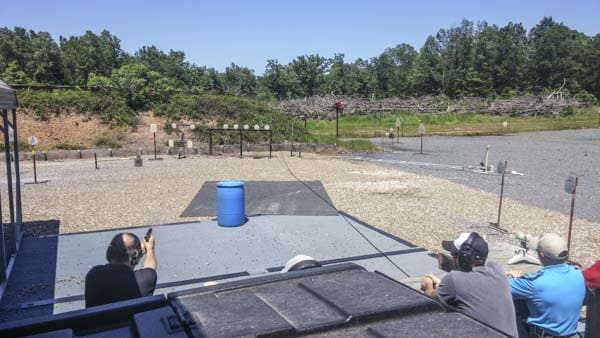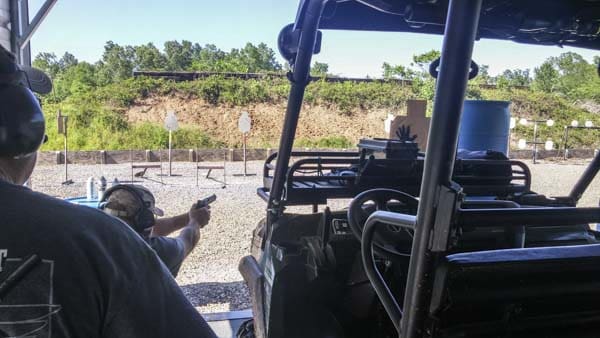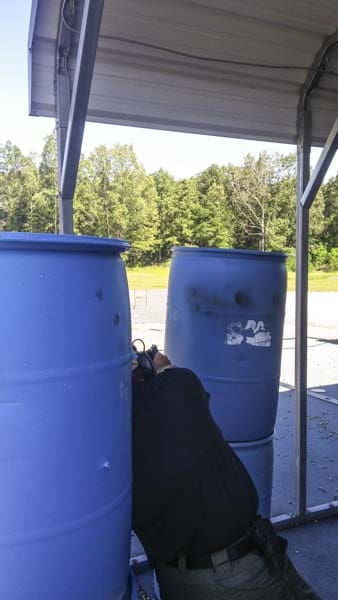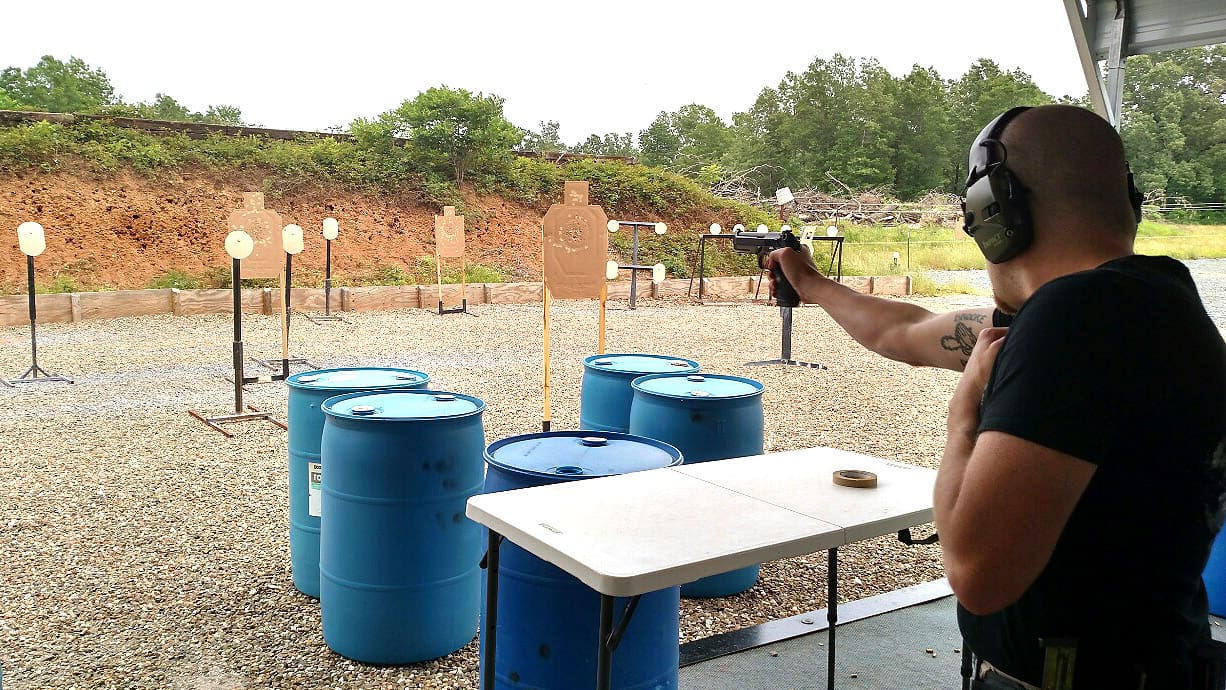Getting to the Wilsons’ northeast Texas ranch wasn’t easy. I drove over eight hours; it was raining buckets the whole way and I had to dodge two tornadoes. I finally made it to Bill and Joyce Wilson’s gorgeous 8000 acre ranch by late Friday evening.
I headed out of the storm into the camp lodge, greeted by the welcome smell of a home-cooked pork chop dinner. Almost everyone was open carrying their pistols. I didn’t read anything encouraging open carry in the course detail, but Bill led by example. A Bill Wilson Custom Carry 1911 was on his hip at all times; it’s pretty clear that he’s a pants on, gun’s on carrier.
Joyce Wilson, the current Executive Director for IDPA, prepared the meal. Dinner was low key and informal. I got plenty of time to get to know my classmates and the Wilson family. About half of the class was from somewhere in Texas, and the other half had either driven down or flown in from Illinois. A couple of the Illinois drivers were Jerry Lizalek and Frank Polak, both great gentlemen who were experienced shooters. It was enlightening, to say the least, to discuss the differences with them between the firearms regulations in the land of Lincon vs. those in here in the Lone Star state. But with the water still falling down, and rising up around it, at around 9pm we called it a night. A few of us made our way down the road — which closely resembled a Texas river — to the bunkhouse trailer to bed down and ready ourselves for the first day’s shooting.
A couple of the Illinois drivers were Jerry Lizalek and Frank Polak, both great gentlemen and experienced shooters. It was enlightening, to say the least, to discuss the differences with them between the firearms regulations in the land of Lincon vs. those in here in the Lone Star state.
With the water still falling down, and rising up around it, at around 9pm we called it a night. A few of us made our way down the road — which closely resembled a Texas river — to the bunkhouse trailer to bed down and ready ourselves for the first day’s shooting.The course formally started at 9am sharp on Saturday with a safety briefing and range walk through. Bill got into his ideas on pistol shooting pretty quickly.
His talk was probably the most information-packed 20 minutes of any firearms course I’ve ever taken. The key takeaway: there are very few things involved in fast, accurate pistol shooting. Gripping the gun tightly to manage recoil, aligning the sights to the target, and squeezing the trigger without moving the sights. That’s it.
Bill rightly pointed out that stance, hand position, foot position, all that stuff, is about wringing that last five percent or so off your shooting time. That’s especially true for real world combat or many of the shooting sports, where you’re moving and/or shooting from cover. As Bill pointed out more than a few times, shooting fast and accurately is really just a matter of performing a few simple tasks — that can be surprisingly difficult to do together.

Bill addressed trigger reset during his opening salvo. He asked if anyone had been taught to feel the gun cycle, then release the trigger to the reset point, then pull the trigger again. I put my hand up. It’s the way my dad taught me to shoot a gun, how my father learned to shoot in the military, and how the military taught me a few decades later.
That’s not how Bill or Ryan do it.
Bill Wilson slaps the hell out of the trigger. Most of the time he’s pushing his trigger finger back out so hard that it’s slapping the inside of the trigger guard before returning to fire. This technique is a hold-over from his double action revolver days. (Bill’s Colt Python collection is truly drool worthy.)
Bill still stages his trigger. He takes up the overtravel, then presses it to break. He does it very, very quickly. His entire focus is on not disturbing the sights as he presses the trigger straight back. After the trigger is pulled, there’s no getting that round back. It’s gone. Bill argues you need to move your finger forward to get that trigger reset as fast as you can, and start pulling back again to take up the overtravel and shoot again.
The advice goes back to his belief that trigger press is one the few things that you have to do well to shoot well. Bill says trigger squeeze is probably the hardest skill to master — and there are only so many things you can focus on at once. He focuses on pulling the trigger straight back and not disturbing the sights. He’s not focused on what happens after that.
It took me both days, and then going home to shoot more, to start to even feel what is going on at that speed. My shooting certainly suffered in the meantime. But once you feel the trigger travel at speed, you feel it, and then you’re chasing consistency.

To do that, you really have to grip the hell out of the gun. How hard? As hard as you can, with both hands, while keeping the sights on target. Ryan Wilson that gave me the best measurement for grip strength. At the end of a shooting session your hands should be tired. At the end of a 20-shot string of fire you should be relieved to let go of the gun.
I thought I was gripping the gun hard enough. But I wasn’t gripping it that hard.
Another challenge: seeing both sights equally. Bill says he learned later in the game that all of the focus on the front sight is misguided. You really have to see both sights equally. The target is a blur, but both of those sights on the pistol have to be in sharp alignment.
I was running a brand new gun for this course; the first round out of the barrel was the first round out for the course. The Wilson Combat CQB Tactical LE’s sights are a little different than my sights on my other guns at home; it has a fiber optic front sight and a flat black U-shaped ledge style rear sight. Unlike my other guns, there’s no reference dot(s) on the CQB’s rear sight.
I was consistently shooting very low with the gun, and I couldn’t figure out why. My groups were fine, but once I moved back to the 25 yard line, I was shooting under an 8″ target every single time. I wasn’t seeing the rear sight in sharp focus, just the front sight.
Joyce Wilson asked me if I was sure I could see the whole front sight sharply in the rear sight. When I slowed down, I realized that no, I was aligning the dot on the front sight with the bottom of the rear sight, and not focusing on aligning both of the tops of the sights together.
When I did that, on day two, I was right on target. But seeing both sights at the same time is very much a learned skill. It’s going to take me some time to get used to it. I’ll take that time in dry fire, as I’m already convinced of the instruction’s value.
During every portion of the course, accuracy was stressed above all. I mean exclusively. At no point did Bill tell anyone to shoot faster. And yet we were all shooting faster than we should have. There were several courses of fire that were untimed; only hits and misses counted. Like many of my other classmates, I rushed my shots.
Bill said it over and over again: you just don’t have to tell people to shoot faster, you have to tell them to slow down. As they say, you can only miss too fast.
Although Bill clearly digs the 1911 platform, he’s also a huge fan of the Beretta 92 series. “If you can get over that initial double action (that’s a big if there, Mr. Wilson) the Beretta’s trigger can be tuned to be about as good as the best 1911s.” Shooting the Beretta 92 standing at 70 yards, Bill puts 100 percent of his rounds into an IDPA target. Not me, but I managed to ring steel at the same distance 50 percent of the time.
When it comes to the Beretta, Bill insists on the decocker-only model. The FS models with which he competed also had to be single-sided safety. He’d mill the safety flush with the safety travel pocket in the slide (as is done on my Wilson Combat carry version of the 92FS).
Bill’s collection of the 92’s is vast and impressive. I had no idea so many versions existed. Neither did Bill. He admitted that he would have rethought his decision to collect them all if he’d known Beretta made so that many different variations.
That said, Bill didn’t bash other firearms manufacturers or pistol platforms. I’d feel totally comfortable bringing any pistol to the course. There were folks shooting Berettas, 1911s from Les Baer and Nighthawk, a race-ready Springfield XD and a bone-stock Walther PPQ. Wilson had good things to say about just about any firearm mentioned.
However, Bill did comment on lightweight polymer framed guns with heavy, long triggers and a light barrel. (He was referring to the Walther PPQ, which he judged to be one of the better examples.) Bill said that a shooter running those guns accurately and fast has to be mindful of how easy it is to move the muzzle during the trigger squeeze. Because of the trigger squeeze, it’s a challenge for some shooters that takes time to overcome — especially when shooting quickly.
He’s Billl Wilson. He’s won just about every title there is, and made his company and fortune shooting and building guns. He could have just said that striker-fired polymer guns suck, like a whole lot of keyboard experts out there. Instead, Bill gave constructive advice on how to shoot the platform well, which is what his students are paying him for.

Throughout the class, Bill used student errors as teaching moments for the rest of the class. One student induced a failure to feed by slightly riding the slide forward on a reload, using the “slingshot” technique. Bill said he sees this fail often — unless someone forcefully slings the gun forward. Or uses the slide release, which he recommends.
Some of you, like me, are probably asking “what’s a slide release”? That’s the little lever on the side that lock the slide. We’ve been told that in a high stress situation we’ll lack the fine motor skills to hit that little lever, so use the slingshot technique instead.
There’s no doubt that using the slide release is faster. One of the most important things in a gun fight: getting your gun into the fight. I don’t buy into the idea that, despite thousand and thousands of repetitions of the “slide release” technique, you will automatically lose it in a high-stress situation. That’s exactly why we train, to overcome fear and hesitation. It can be done.
But I still prefer the slingshot technique. I can do it with cold weather gloves on or when my hands are sweaty and bloody. I’ve tried the slide release technique in those conditions, and it doesn’t work for me. Then again, how often is that a concern in the civilian world?
I spent a lot of day one and part of day two attempting the slide release method — and failed with it over and over again. I just kept missing the release. Of course, it was new to me, against my previous training, and I was using a gun I’d never fired prior to the course. I’ll give the “slide release” technique some more effort before accepting or rejecting it.
Another one of the other techniques Bill uses and promulgates: keeping the gun extended in front of you and pointed at the target while moving from one station to the next. He recommended the technique after I kept bringing in my gun during transitions. The faster shooter next to me did not.
Leaving the gun out there is difficult for me. I’ve trained for many years to pull the gun into a ready or position if I’m moving. It’s become a consistent reaction once I’m done shooting. So I asked Bill why he didn’t pull the gun in when moving. His answer was simple: “Unless you’re at contact distance, it’s slower.” And that’s the end of that.
Bill’s right, of course. I tried it on the second day for a while, I found that yes, I could put the sights on target much faster if I kept the gun in front of me while I moved. But I just don’t see the real world application of this technique.
If I’m unaware of the exact location of the threat, such as clearing the inside of a multiple room structure, the best way to retain your pistol is to keep it close to your body. The last thing you want it to do: turn a corner before your eyes do. If you’re moving towards a target and within range, you should be shooting at that target. And if you can see the target and are behind cover and in range, you should be shooting at the target.
There were a few issues like this throughout the course; techniques that Bill was selling that others weren’t buying. It has to be said: the naysayers don’t have Bill Wilson’s walls of trophies in virtually every shooting discipline. He’s proven they work.
But Bill never pulled rank. “Try it,” he’d say. “Try two or three different ways of doing it. See what works for you.” I’ve had instructors with far fewer qualifications than Bill Wilson tell me theirs was the only way. It was refreshing to see real professionalism in action.





you really have to grip the hell out of the gun. How hard?
It’s called a “convulsive grip.” That’s the way I was taught to hold a snubby. It’s as if I’m trying to crush the grip into sawdust.
After shooting snubbies for so long, I crush every handle the same way.
As an extra-added bonus, the convulsive grip lowers blood pressure. No, really, it does.
I believe the point is not so much lowering your blood pressure as it is lowering the blood pressure of the guy you’re shooting at.
“Bill still stages his trigger. He takes up the overtravel, then presses it to break.”
Don’t you mean pretravel?
Taking up overtravel is also known as ND.
Yup
Until I was around 60, I never understood “focus on the front sight”, just didn’t make any sense. After my eyes started to go, I discovered that was because I always had focused on the rear sight, the front sight, and the target, all at the same time, for both pistols and rifles! Now I have moved far down the pike, cannot focus on either sight (farsighted), at all, so am trying to move to lasers, scopes, and red dots, since I can see the target just fine. What I am saying here is that one size does not fit all in this regard, perfect vision (I used to be 20/16 in both eyes, near and far) does things one way, nearsighted another way, and farsighted yet another, severity of vision problems is also a player.
“I always had focused on the rear sight, the front sight, and the target, all at the same time”
Unless you did your shooting in some alternate dimensional reality, no, you didn’t do that. In our universe, and with our set of the Laws of Physics, your eyes are not capable of focusing/resolving the light from 3 different objects at three different distances from you at the same time. If all three objects were in almost exactly the same plane, or their relative distances from each other were trivial compared to distance from you to them, then the difference in focus between the three would not likely be noticeable. So if you were shooting at a target at point blank range from your gun, and your arms are about 30 yards long, then sure, what you say could appear to be true. But even then it wouldn’t ACTUALLY be true, and I’m pretty sure you don’t have 30-yard-long arms.
I completely agree with your article. I’ve taken 2 classes taught by Bill, Ryan and Joyce- it is easily the best block of instruction I’ve ever had. My skills are no where near their level, but it doesn’t matter, they teach to your needs.
Which thumb do you use on the slide release? I shoot a Gold Cup right handed and use my left thumb on the release. It works and I don’t have to change the position of my right hand.
The “correct” version is the right hand thumb for a right handed shooter. However, Ryan Wilson uses his left hand thumb and is a right handed shooter, and is extremely fast with it. He started practicing it when he was very young, like 7, with hands too small to reach the controls with his right. So he’s done it tens of thousands of times with his left, and he’s great with it.
“you need to move your finger forward to get that trigger reset as fast as you can”
“How hard? As hard as you can, with both hands, while keeping the sights on target”
“focus on the front sight is misguided”
“uses the slide release, which he recommends.”
Hell yeah! Exactly what i found out. PREACH IT!
“I spent a lot of day one and part of day two attempting the slide release method — and failed with it over and over again. I just kept missing the release”
That’s part of why i like being a lefty shooter. It’s a whole better world.
Never been a fan of wilson combat guns, nor do i agree with his “use the heaviest recoil spring that’s reliable”, but these advices are really golden.
I agree with you that pulling the gun in is more logical in real world situations. Holding the gun extended the whole time may be great for a competition stage, but if you’re searching a building your arms will tire quickly. And bringing it in to a ready position makes it easier to avoid gun grabs, makes it easier to maneuver around, and makes entering rooms smoother.
JWT, I have a general training question:
There are lots of trainers and classes out there, and the classes aren’t exactly cheap.
What does one do when one takes a course, and the trainer’s instructions directly conflict with what an earlier course’s trainer taught?
It seems to me that problem grows exponentially the more courses one takes…
I’d try the new way just because i paid money for it.
If it’s really inferior to what you currently use after careful thought and practice, and it has no place as an alternative skillset for specific situations, just ditch it.
Speaking of direct conflict, true personal story:
When i was in canada applying for their licence, the trainers taught the whole class full of noobs to look into the muzzle to make sure there’s no obstruction. You didnt read that wrong. It was a two-day intensive course, 16hr just for the gun permit, and i probably looked down the muzzle of assembled but “empty” guns 100 times or so to practise for the exam at the end. Something NEVER EVER down before those two days. Talk about the need to untrain some training scars.
Yup, I’, agreeing with James. Commit time to trying out new things, before you decide if they work or do not work for you. After all, if you walked away from a class not trying anything new, you didn’t get your money’s worth. But it’s not doctrine, it’s advice.
Bill Wilson still finding ways to squeeze money out of morons.
Take one of his classes Nick and you’ll find out how much of a moron you are. The best money/time I’ve ever spent!
Good write up JWT. I also attended this class and concur with JWTs conclusions. The training resulted in a step improvement in my shooting. I would recommend Bill’s training to anyone interested in improving their handgun skills for self defense or competitive shooting.
Bill quit IPSC/USPSA supposedly because it became an equipment race. He invented IDPA to keep shooting and selling iron sight 1911’s. Nothing wrong with that I guess. Teaching competition shooting is one thing. Teaching “combat” pistol shooting is another.
Comments are closed.